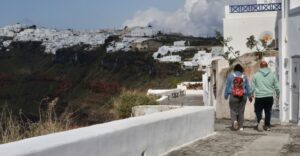The seismic tremors in the southeastern Cyclades continue, and by decision of the General Secretariat for Civil Protection, the Municipality of Santorini has been declared in a state of emergency.
“By decision of the General Secretariat for Civil Protection, the Municipality of Santorini declares a state of emergency to address the emergency needs and manage the consequences resulting from the seismic activity that has been occurring recently in the above-mentioned area. This declaration will be in effect from February 1 and will last for one month, until March 1,” the announcement states.
Lekkos: Small chances for the extreme scenario of a 6 magnitude earthquake
“The seismic activity in Santorini continues at an especially intense rate,” emphasized Professor of Seismology and Natural Disasters Efthymios Lekkos on SKAI radio.
He noted that the relevant authorities are prepared for all scenarios, even the extreme one involving an earthquake of around 6 on the Richter scale.
“The extreme scenario has very small chances and may cause damage to old, unmaintained houses and possibly landslides in the Caldera area,” Mr. Lekkos stated, adding that scientific committees will meet on Saturday morning to recommend measures to the government that will take effect next week.
“There are three scenarios at the moment. The first is that we will remain at these magnitudes for a few more days or weeks. The second is that we will experience a larger earthquake of around 5.5, which will relieve the situation and cause no issues for the island. The third and extreme scenario is to have an earthquake near 6 Richter. In that case, there could be damage to old, unmaintained houses and possibly landslides in the Caldera area.”
Over 6,400 earthquakes from January 26 to February 3
More than 6,400 earthquakes occurred in the Santorini-Amorgos zone from January 26 to February 3, according to a statement by the Interdisciplinary Risk and Crisis Management Committee of EKPA.
Based on the data, over 1,300 earthquakes occurred on February 2, and over 1,400 on February 3 in the area.
The committee members indicate that the seismic activity in this area likely displays the characteristics of a seismic swarm, as no earthquake with a clearly larger magnitude, which could be considered the main shock, has occurred so far.
“Moreover, the rate of seismicity is increasing, and the aftershock sequences are characterized by a decreasing temporal distribution of earthquakes, with the largest aftershock typically being smaller by ~0.5 compared to the main earthquake,” the researchers add.
Possible scenarios
It is likely, they estimate, that this is a swarm containing larger earthquakes. “One possibility is for the activity to continue but with gradually smaller magnitudes and fewer earthquakes, though it may last for several months, as in the case of the Thebes seismic swarm.”
Another possibility is “this swarm to trigger the rupture of a significant section of a large active fault in the area, leading to a main earthquake, and then the activity would take the form of a typical aftershock sequence. In such a case, the seismic swarm that preceded the main earthquake would be retroactively considered a foreshock sequence.”
The scientists note that although the observed seismic activity is taking place within the active volcanic arc of the South Aegean, it is not directly related to any known volcanic center, but appears to have activated a system of normal faults, oriented from southwest to northeast, in the marine basin of Anydros. “Seismic swarms, especially those located in or near volcanic environments, are often triggered by the infiltration of fluids into the faulted rock, which facilitates ruptures, in combination with stress transfer caused by the tectonic earthquakes themselves,” they note.
Detailed announcement:
During the period from February 2 to the early hours of February 5, 2025, seismicity in the Santorini-Amorgos zone intensified even further. The analysis of seismic data up to February 3, updated with the use of machine learning, showed more than 1,300 earthquakes on February 2 and more than 1,400 earthquakes on February 3, totaling over 6,400 earthquakes from January 26 to February 3, of which over 4,800 had a magnitude greater than M³1.0 and more than 800 had a magnitude greater than M³2.5.
The number of earthquakes with a magnitude greater than M³2.5 has been gradually increasing each day, with counts of 0, 1, 2, 6, 9, 25, 45, 340, and 437 earthquakes from January 26 to February 3. On February 2, 5 earthquakes with M³4.5 occurred, on February 3, 7 earthquakes, and on February 4, 9 earthquakes. The largest earthquake had a magnitude of 4.6 on February 2, while on February 3 and 4, three earthquakes with magnitudes between 4.9-5.0 and four others with a magnitude of 4.8 occurred. In the early hours of February 5, seismic activity continued near Anydros. Over 30 earthquakes have been detected, with the largest reaching magnitude 4.4.
The distribution of seismic foci on February 2 started concentrated around the midpoint of the distance between Anydros and Santorini, and then migrated northeast towards Anydros. On February 3, seismicity remained mostly concentrated southwest of Anydros, with small clusters of earthquakes occurring to the west and north of Anydros, at generally distances of less than 10 km from it. According to the daily seismic data analysis from the Seismology Laboratory of EKPA, on February 4, activity remained mainly to the west of Anydros but spread slightly to the east. From February 1 to February 4, the outer edge of the seismically active zone appears to have migrated northeastward at a rate of approximately 4-5 km/day in a direction of ~B40°A. From the machine learning analysis, it appears that during various bursts, the migration occurred at even higher speeds in certain areas, covering shorter distances.
The seismic activity observed so far in the Santorini-Amorgos zone likely exhibits the characteristics of a seismic swarm, as no earthquake with a magnitude significantly greater than the others has occurred, which could be classified as the main earthquake. Additionally, the rate of seismicity is increasing, and the aftershock sequences are characterized by a decreasing temporal distribution of earthquakes, with the largest aftershock typically being smaller by ~0.5 compared to the main earthquake. Although it is likely a swarm containing large earthquakes, compared to other recent seismic swarms in Greece, one possibility is that the activity will continue but with gradually smaller magnitudes and fewer earthquakes, and may last for many months, as was the case with the Thebes seismic swarm. However, a second possibility is that this swarm could trigger the rupture of a significant section of a large active fault in the area, causing a main earthquake, and then the activity would take the form of a typical aftershock sequence. In such a case, the seismic swarm that preceded the main earthquake would be retroactively classified as a foreshock sequence. Although the observed seismic activity occurs within the active volcanic arc of the South Aegean, it is not directly related to any known volcanic center, but it appears to have activated a system of normal faults, oriented from southwest to northeast in the marine basin of Anydros. Seismic swarms, especially those near or within volcanic environments, are often triggered by the infiltration of fluids into the faulted rock, facilitating ruptures, in combination with stress transfer caused by the tectonic earthquakes themselves.
The ability to detect microearthquakes is expected to improve, and the uncertainties in locating the epicenters will decrease in the coming days, as all entities in the National Seismograph Network are working on increasing the density of local stations. It is noted that as part of the intensive monitoring of the ongoing seismic activity in the Santorini-Amorgos area, members of the two Laboratories (Seismology and Geophysics) of the Department of Geophysics and Geothermy, as well as the Interdisciplinary Risk and Crisis Management Committee of EKPA, will visit Ios and Santorini to install and maintain seismographs and conduct ground deformation measurements.
Ask me anything
Explore related questions





